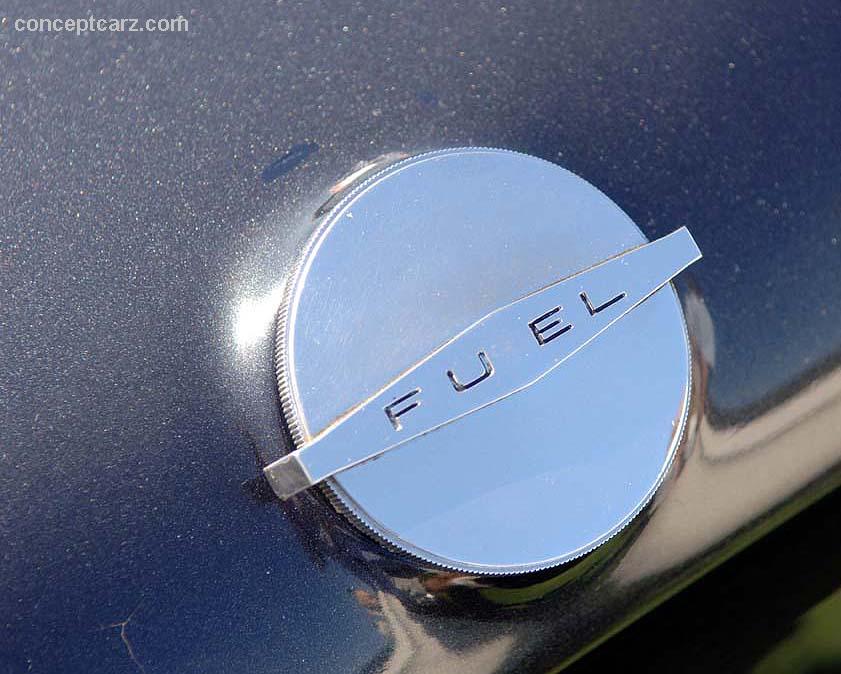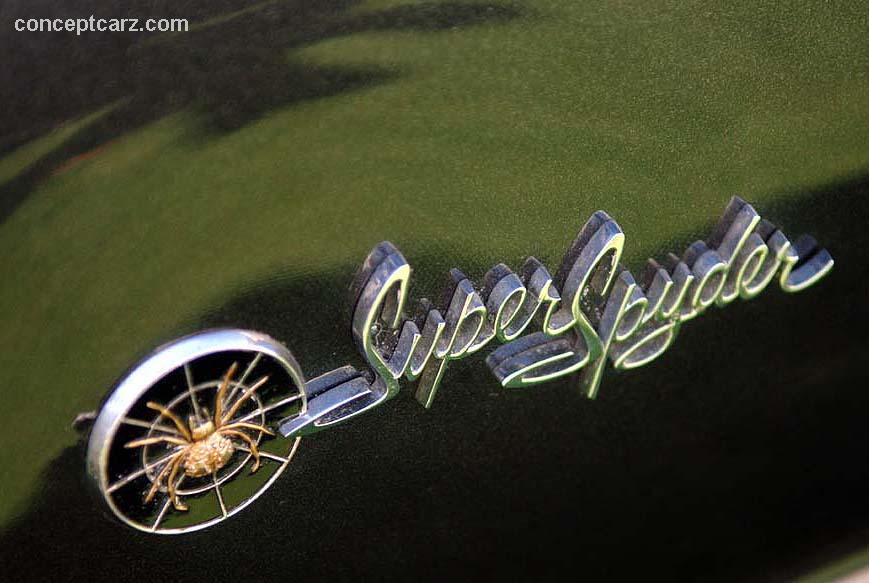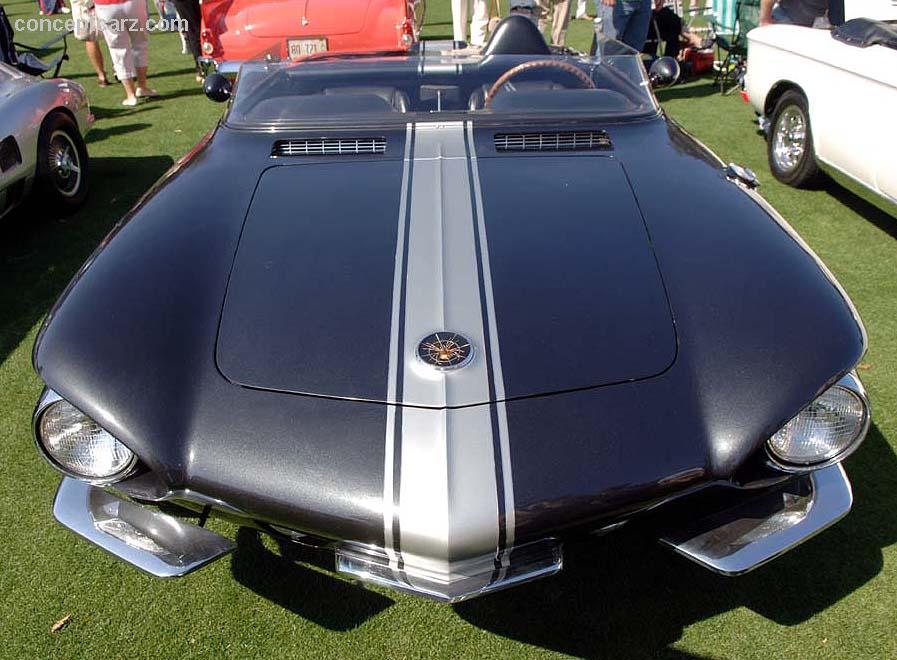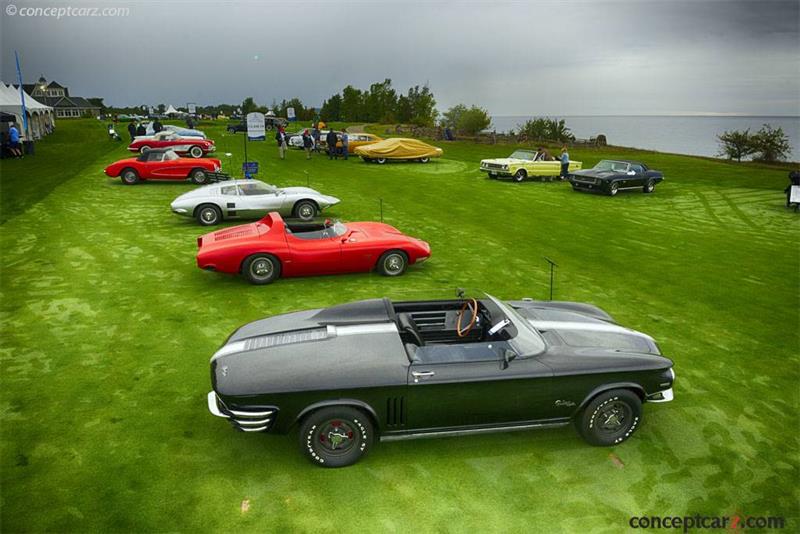The Chevrolet Corvair was an intriguing canvas for automotive designers, with its unconventional rear-engine configuration birthing drawings that were dramatically different from those seen before. Its compact platform was sporty and youthful and many of the designs catered to these qualities, complemented by the vehicle's technically advanced underpinnings. Along with the numerous concept cars created - some even coming close to production - the Corvair was built in a variety of body style configurations and trim levels, from convertibles to club coupes, and from sedans to the iconic Rampside Pickup. 
Spyder
View info and historyThe first concept to bear the Corvair nameplate was the Corvette Corvair Concept, a Corvette-based fastback coupe using the chassis and powertrain from the Corvette, with a European and aircraft-influenced design. In 1954, it was shown at the GM Motorama in New York City, but its fate was sealed with the slow sales of the Corvette, ultimately being sent to the crusher. GM revived the Corvair name in 1960 for its rear-engined compact car, followed by a concept dubbed the Sebring Spyder in 1961, foreshadowing the convertible that would follow a year later. It was a near-production concept with a few unique styling elements including a low-raked windscreen, fixed door windows, and dual headrests built into the rear deck.The GM Design Studio, under the direction of Bill Mitchell, would build four concept cars atop the Corvair platform, including the XP 785 Super Spyder.The Super Spyder Concept
The Super Spyder was built on the 1961 Corvair platform but with a wheelbase shortened by fifteen inches. It used the rear-mounted, horizontally-opposed turbocharged six-cylinder 150-horsepower engine and transaxle from the production Monza Spyder along with the four-wheel independent suspension system. It retains some of the production car's styling cues for the front, but the side profile was much different, revealing the racing-inspired windscreen, extended fiberglass tonneau cover, a driver's head rest that tapered into the engine cover, and three chrome exhaust pipes exiting behind both rear wheels. Three vertical louvers were positioned directly in front of the rear wheel opening, directing air flow to the vehicle's mechanical components.
Spyder
View info and historyThe Corvair Super Spyder Concept remained a styling exercise and did not enter production. Additional Corvair-based concept cars that followed include the Corvair Monza GT and SS Concept Car and both made their public debut in 1963 at the New York Auto Show. Both wore styling by Larry Shinoda under Bill Mitchell's direction. The coachbuilder Pininfarina built a coupe design with a unique headlight design. It, too, remained in the concept stage, never making it to the European-intended market. Designer John Fitch transformed his sketches to sheet metal with the Fitch Phoenix concept built on a 95-inch Corvair wheelbase (13 inches shorter than stock) and powered by a 170-horsepower Weber carbureted Corvair engine. Only the prototype was created as its fate was sealed when General Motors ceased production of the Corvair.
Spyder
View info and historyThe Corvair Astro I was a futuristic design with a small frontal area and extremely low roofline, demonstrating the harmony that could be achieved between aesthetics and aerodynamics. Its bodywork was formed from fiberglass and the roof contained an intricate mirror system to provide the driver with unobstructed rearward vision. Centrifugal blowers were utilized to cool the engine while keeping drag-inducing body openings to a minimum. At less than three feet high, it was the lowest concept model ever created by GM Design, so low that passengers had to use elevator seats to get in and out. The Astro II that followed a year later was a collaboration between GM Design and GM Research and a much closer production-practical sports car. It was another design in a series of mid-engine concepts created by Mitchell and Corvette Chief Engineer Zora Arkus-Duntov, with input from Larry Shinoda, as a potential future Corvette. The Astro III of 1969 was a two-passenger experimental car resembling an executive jet aircraft. It had four wheels even though the front pair were placed close together under its nose, appearing as though it had a 'tricycle' design. Mounted midship was a Model 250-C18 gas turbine engine, and a power canopy top moves forward and upward for entry, and rear vision is provided by closed-circuit TV with a screen on the center console.1969 was the final production year of the Corvair just 6,000 examples were built. One example was custom-built for Bill Mitchell, the Vice President, Design, General Motors Corporation. It features a special pearlescent tangerine paint with Daytona Radial Spoke wheels and a slightly tuned engine.
by Daniel Vaughan | Jun 2022

Spyder
View info and history
The Super Spyder was built on the 1961 Corvair platform but with a wheelbase shortened by fifteen inches. It used the rear-mounted, horizontally-opposed turbocharged six-cylinder 150-horsepower engine and transaxle from the production Monza Spyder along with the four-wheel independent suspension system. It retains some of the production car's styling cues for the front, but the side profile was much different, revealing the racing-inspired windscreen, extended fiberglass tonneau cover, a driver's head rest that tapered into the engine cover, and three chrome exhaust pipes exiting behind both rear wheels. Three vertical louvers were positioned directly in front of the rear wheel opening, directing air flow to the vehicle's mechanical components.

Spyder
View info and history

Spyder
View info and history
by Daniel Vaughan | Jun 2022
Related Reading : Chevrolet Corvair History
magazine named it one of The 50 Worst Cars of All Time. Ralph Nader highlighted its design flaws in his influential book Unsafe at Any Speed. Yet the Chevrolet Corvair, which faced more negative press during its lifespan than any other car of the era, continues to have a loyal following of true enthusiasts. Different from any American cars before or since, the unique Corvair has become most....
Continue Reading >>
Continue Reading >>
Related Reading : Chevrolet Corvair History
The Corvair came on the scene in 1959 and featured a flat-six engine mounted in mid-ship. Even with putting the engine in the middle of the vehicle, the weight distribution was not evenly distributed. The engine sat behind the rear axle and this actually caused handling problems. The vehicles main competition was the VW Bug and the Porsche 911. It was originally built to compete with the Bug, but....
Continue Reading >>
Continue Reading >>
Chevrolet Monthly Sales Volume
March 2023
398,141
1962 Chevrolet Corvair Super Spyder Concept Vehicle Profiles
Recent Vehicle Additions
Related Automotive News

An exclusive Ad Personam Ultimae Roadster created in homage to the unique Miura Roadster
The final Aventador signals end of production for the Lamborghini V12 internal combustion engine
The final Aventador LP 780-4 Ultimae, exiting the gates of Automobili Lamborghinis SantAgata home for delivery to its Swiss owner, is a special...

The Mid-Engine Corvette at the Amelia Island Concours d'Elegance
With the recent introduction of the Chevrolet C8 Corvette, the first production mid-engine Corvette sports car, the 2020 Amelia Island Concours dElegance took the opportunity to tell the story of the mid-engine Corvette legacy. The canvas...

CHEVROLET TO SHOW CHAPARRAL VISION GRAN TURISMO CONCEPT
Boundary-pushing, Chevy-powered race cars changed motorsports design
DETROIT – When racers Jim Hall and Hap Sharp founded Chaparral Cars in 1962, few could have guessed how they would shake up the conformities of the racing world – and...

All-new Alfa Romeo 4C Debuts at the 2014 New York Auto Show, Marks the Iconic Italian Brand's Return to North America
2014 New York Auto Show debut of all-new 2015 Alfa Romeo 4C coupe and limited-edition 4C Launch Edition marks the Italian sports car brands return to the North American market
Mid-engine proportions and inspiration from the brands racing traditio...

MIKE RYAN'S BANKS SUPER-TURBO PIKES PEAK FREIGHTLINER A UNIQUE BIG ONE TO WATCH IN PIKES PEAK OPEN DIVISION
Colorado Springs, June 20--------The Freightliner Cascadia Pikes Peak Special racing machine of Mike Ryan (Santa Clara, CA) is truly like no other entry in the Pikes Peak Open division during the 91st edition of the Pikes Peak International Hill...































